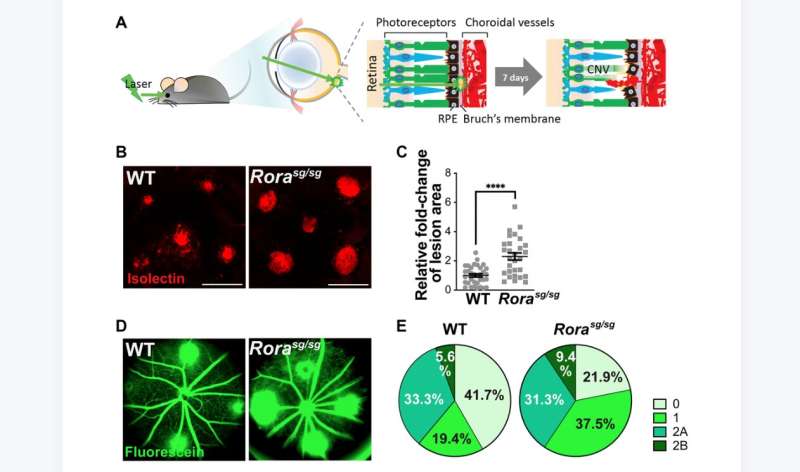This article has been reviewed according to Science X's editorial process and policies. Editors have highlighted the following attributes while ensuring the content's credibility:
fact-checked
proofread
Genetic deficiency and pharmacological modulation of RORα regulate laser-induced choroidal neovascularization

A new research paper titled "Genetic deficiency and pharmacological modulation of RORα regulate laser-induced choroidal neovascularization" has been published in Aging.
Choroidal neovascularization (CNV) causes acute vision loss in neovascular age-related macular degeneration (AMD). Genetic variations of the nuclear receptor RAR-related orphan receptor alpha (RORα) have been linked with neovascular AMD, yet its specific role in pathological CNV development is not entirely clear.
In this new study, researchers from Harvard Medical School, UF Scripps Biomedical Research and University of Arizona showed that RORα was highly expressed in the mouse choroid compared with the retina, and genetic loss of RORα in staggerer mice (Rorasg/sg) led to increased expression levels of Vegfr2 and Tnfa in the choroid and retinal pigment epithelium (RPE) complex.
"Here, we investigated whether RORα regulates CNV using a mouse model of laser-induced CNV, mimicking the neovascular features of wet AMD. We found that expression of RORα was enriched in the mouse choroid/RPE complex and upregulated in laser-induced CNV," the researchers explain.
In a mouse model of laser-induced CNV, RORα expression was highly increased in the choroidal/RPE complex post-laser, and loss of RORα in Rorasg/sg eyes significantly worsened CNV with increased lesion size and vascular leakage, associated with increased levels of VEGFR2 and TNFα proteins. Pharmacological inhibition of RORα also worsened CNV. In addition, both genetic deficiency and inhibition of RORα substantially increased vascular growth in isolated mouse choroidal explants ex vivo. RORα inhibition also promoted angiogenic function of human choroidal endothelial cell culture.
The researchers conclude, "Together, our results suggest that RORα negatively regulates pathological CNV development in part by modulating angiogenic response of the choroidal endothelium and inflammatory environment in the choroid/RPE complex."
More information: Chi-Hsiu Liu et al, Genetic deficiency and pharmacological modulation of RORα regulate laser-induced choroidal neovascularization, Aging (2023). DOI: 10.18632/aging.204480




















